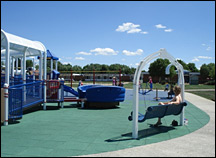The Principles of Universal Design
Principle 1: Equitable Use
Definition
Equitable Use dictates that the design be useful and marketable to people with diverse abilities.
 Example
Example
The sidelight window provides an opportunity for all users - whether tall or short, seated or standing - to have the same experience of looking outside.
Example
This universally designed playground was planned for users to enter from all directions including the school, adjacent sports field and parking lot. The composite structure is designed to accommodate users with assistiez devices where they can enter from one end and travel independently to all pieces of equipment without the need to leave their assistiez device.
Guidelines
- Provide the same means of use for all users; identical whenever possible, equivalent when not.
- Avoid segregating or stigmatizing any users.
- Provisions for privacy, security, and safety should be equally available to all users.
- Make the design appealing to all users.

